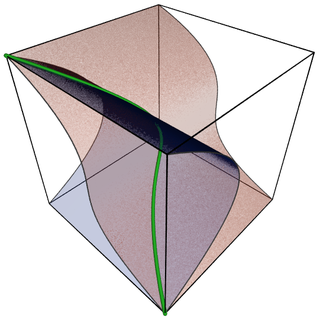
Algebraic geometry is a branch of mathematics which uses abstract algebraic techniques, mainly from commutative algebra, to solve geometrical problems. Classically, it studies zeros of multivariate polynomials; the modern approach generalizes this in a few different aspects.
In commutative algebra, the prime spectrum of a commutative ring R is the set of all prime ideals of R, and is usually denoted by ; in algebraic geometry it is simultaneously a topological space equipped with the sheaf of rings .

In algebraic geometry and commutative algebra, the Zariski topology is a topology defined on geometric objects called varieties. It is very different from topologies that are commonly used in real or complex analysis; in particular, it is not Hausdorff. This topology was introduced primarily by Oscar Zariski and later generalized for making the set of prime ideals of a commutative ring a topological space.

Algebraic varieties are the central objects of study in algebraic geometry, a sub-field of mathematics. Classically, an algebraic variety is defined as the set of solutions of a system of polynomial equations over the real or complex numbers. Modern definitions generalize this concept in several different ways, while attempting to preserve the geometric intuition behind the original definition.
In mathematics, a scheme is a mathematical structure that enlarges the notion of algebraic variety in several ways, such as taking account of multiplicities and allowing "varieties" defined over any commutative ring.
In algebraic geometry, a proper morphism between schemes is an analog of a proper map between complex analytic spaces.
In mathematics, algebraic geometry and analytic geometry are two closely related subjects. While algebraic geometry studies algebraic varieties, analytic geometry deals with complex manifolds and the more general analytic spaces defined locally by the vanishing of analytic functions of several complex variables. The deep relation between these subjects has numerous applications in which algebraic techniques are applied to analytic spaces and analytic techniques to algebraic varieties.
In algebraic geometry, an algebraic variety or scheme X is normal if it is normal at every point, meaning that the local ring at the point is an integrally closed domain. An affine variety X (understood to be irreducible) is normal if and only if the ring O(X) of regular functions on X is an integrally closed domain. A variety X over a field is normal if and only if every finite birational morphism from any variety Y to X is an isomorphism.
In algebraic geometry, a Noetherian scheme is a scheme that admits a finite covering by open affine subsets , where each is a Noetherian ring. More generally, a scheme is locally Noetherian if it is covered by spectra of Noetherian rings. Thus, a scheme is Noetherian if and only if it is locally Noetherian and compact. As with Noetherian rings, the concept is named after Emmy Noether.
In mathematics, a Noetherian topological space, named for Emmy Noether, is a topological space in which closed subsets satisfy the descending chain condition. Equivalently, we could say that the open subsets satisfy the ascending chain condition, since they are the complements of the closed subsets. The Noetherian property of a topological space can also be seen as a strong compactness condition, namely that every open subset of such a space is compact, and in fact it is equivalent to the seemingly stronger statement that every subset is compact.
In mathematics, real algebraic geometry is the sub-branch of algebraic geometry studying real algebraic sets, i.e. real-number solutions to algebraic equations with real-number coefficients, and mappings between them.
In algebraic geometry, Zariski's main theorem, proved by Oscar Zariski, is a statement about the structure of birational morphisms stating roughly that there is only one branch at any normal point of a variety. It is the special case of Zariski's connectedness theorem when the two varieties are birational.
In algebraic geometry, a Zariski–Riemann space or Zariski space of a subring k of a field K is a locally ringed space whose points are valuation rings containing k and contained in K. They generalize the Riemann surface of a complex curve.
In algebraic geometry, the smooth completion of a smooth affine algebraic curve X is a complete smooth algebraic curve which contains X as an open subset. Smooth completions exist and are unique over a perfect field.
In algebraic geometry, a smooth scheme over a field is a scheme which is well approximated by affine space near any point. Smoothness is one way of making precise the notion of a scheme with no singular points. A special case is the notion of a smooth variety over a field. Smooth schemes play the role in algebraic geometry of manifolds in topology.
This is a glossary of algebraic geometry.
In algebraic geometry, Nagata's compactification theorem, introduced by Nagata, implies that every abstract variety can be embedded in a complete variety, and more generally shows that a separated and finite type morphism to a Noetherian scheme S can be factored into an open immersion followed by a proper morphism.
In algebraic geometry, Chow's moving lemma, proved by Wei-Liang Chow, states: given algebraic cycles Y, Z on a nonsingular quasi-projective variety X, there is another algebraic cycle Z' on X such that Z' is rationally equivalent to Z and Y and Z' intersect properly. The lemma is one of key ingredients in developing the intersection theory, as it is used to show the uniqueness of the theory.
In mathematics, Castelnuovo's contraction theorem is used in the classification theory of algebraic surfaces to construct the minimal model of a given smooth algebraic surface.



